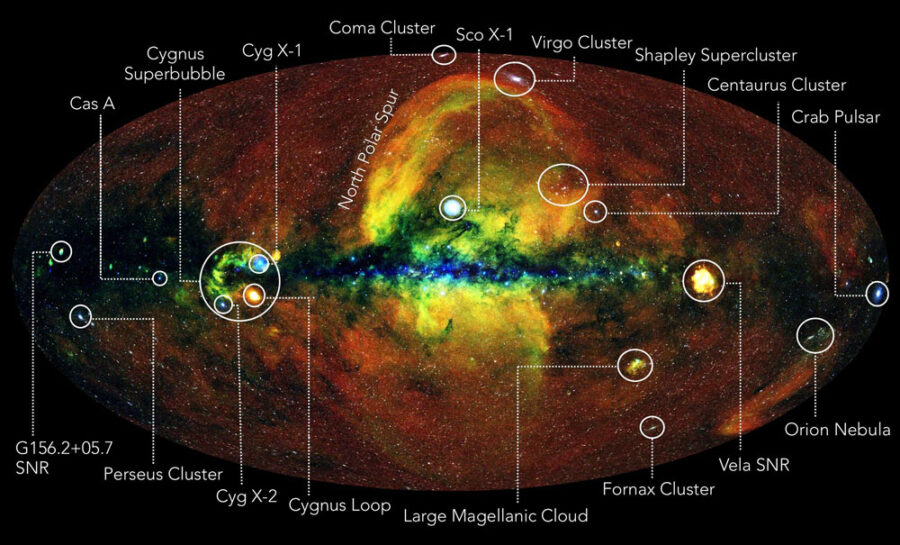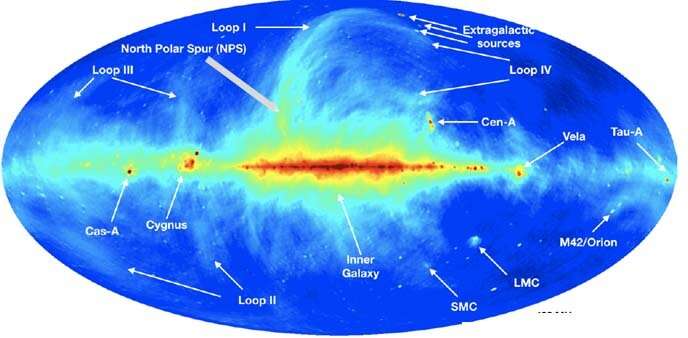Astronomers are making the case that the North Polar Spur — a ridge of gas sticking out of the galactic plane — is part of the Local Bubble, blown out by long-ago supernovae.
The North Polar Spur is a fantastically large ridge of hot, X-ray- and radio-emitting gas that rises above the plane of the galaxy. It starts near Sagittarius and extends to Scorpius, Lupus, and past Centaurus.

J. Sanders, H. Brunner & eSASS team (MPE) / E. Churazov, M. Gilfanov (on behalf of IKI)
But ever since its discovery, there’s been debate as to what it actually is.
The ridge could be the edge of the nearby Local Bubble, blown out by a cluster of long-ago supernova bombs exploding (relatively) close to the solar system.
Or, if it’s farther away, it could outline a gargantuan cavity carved out by even stronger activity in our galactic center. Indeed, the spur seems to line up with the so-called Fermi Bubbles, which extend above and below the Milky Way’s disk. These ovals of gamma-ray emission likely mark activity around our galaxy’s central black hole several million years ago, when it enjoyed a snack of some sort. But is the overlap of the X-ray/radio spur and the gamma-ray emission of the Fermi Bubbles just coincidence?
The trouble is, even though we can see the North Polar Spur on the sky, we don’t know how far away it is — hundreds of light-years or tens of thousands? — and that makes measuring its size difficult, much less understanding where it comes from.
Now, new analysis of data from the European Space Agency’s Gaia mission — which is in the process of measuring the brightness, colors, and distances to a billion stars in the Milky Way — could help pinpoint the spur’s location and thus its source.
Stars In Between
Kaustav Das (Indian Institute of Technology) and colleagues report in the Monthly Notices of the Royal Astronomical Society (preprint available online here) that the structure must be only several hundred light-years away.
To gauge the distance to the North Polar Spur, the team gauged the colors of thousands of stars in its direction. Just as dust particles in our atmosphere redden the Sun’s light at sunset, the amount the stars’ light reddens gives a measure of the intervening dust.
The North Polar Spur radiates X-rays, not visible light, and X-rays pass right through dust grains. But where there’s dust, there’s gas — and gas does absorb X-rays. Das and his colleagues were able to relate the amount of dust they measured to the amount of gas absorption seen in X-ray observations taken by the XMM-Newton satellite.
To account for the amount of intervening dust and gas, the team finds that most of the North Polar Spur must be within 500 light-years of Earth and is likely part of the Scorpius-Centaurus Association, a region of heavy nearby star formation.
“I think the local bubble was formed roughly 10 million years ago when a cluster of stars went boom,” Das says. “These supernova explosions were not close enough to affect life on Earth, but the solar system is inside the bubble.”

Haslam, C.G.T. et al., Astron. Astrophys. Suppl. Ser. 1982
Dust vs. Gas
But not everybody agrees with these conclusions, maintaining that at least some part of the North Polar Spur is far away. “I am not convinced the North Polar Spur is a local object,” says Daniel LaRocca (Penn State).
Instead, LaRocca thinks there are two structures that just happen to overlap in the sky: a dim, nearby supernova-blown bubble and a larger, hotter structure that’s much farther away and associated with the Fermi Bubbles.
The main issue, LaRocca explains, is that the nearby part doesn’t appear to be hot enough to emit X-rays. That said, Das points out that scenarios exist in which the X-rays do originate nearby.
Moreover, while the team uses X-ray absorption to nail down the spur’s distance, LaRocca argues that the absorption measurements themselves aren’t all that reliable.
Whether near or far, the North Polar Spur is a relic of a bygone era — one that future investigations will help reveal more fully.
 0
0









Comments
You must be logged in to post a comment.